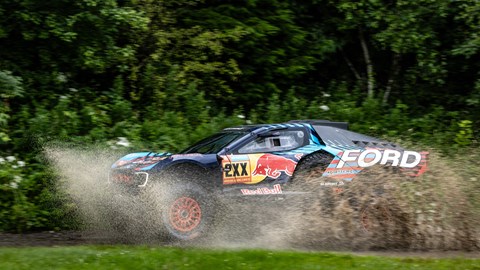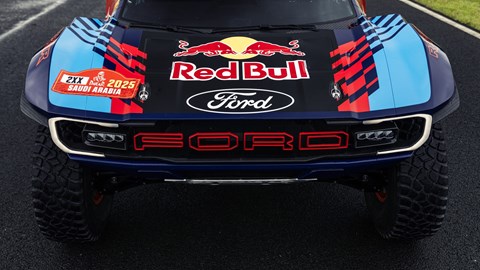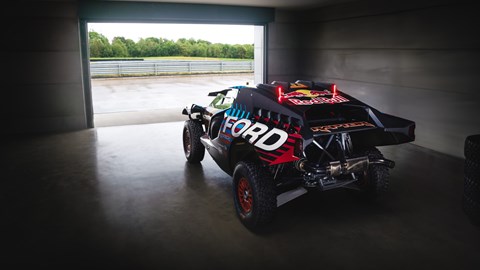Ford is set to make a splash on its debut in the Dakar Rally, which gets underway on 3 January in Saudi Arabia with this, the Ford Raptor T1+. And it stands a strong chance of success, with a stellar driver line-up led by five-time Dakar winner Carlos Sainz.
What exactly is the Ford Raptor T1+?
It’s front grille and headlights may bear a passing resemblance to those of the road-going Ranger Raptor, but the similarities end there. The Raptor T1+ is a completely bespoke machine with a spaceframe chassis that’s designed solely to contest the Dakar and other rounds of the FIA World Rally-Raid Championship (W2RC) in the Ultimate class.
Power comes from a 5.0-litre Coyote V8 engine that’s also found in the Ford Mustang. It produces 360bhp, which may not sound like much, but power is limited by the T1+ category regulations. Torque is more important for desert racing anyway, but even that is limited by the FIA. Power is sent to all four wheels via a six-speed sequential gearbox supplied by Sadev, and a limited-slip differential.

Must have serious suspension
Indeed it does. Like all the T1+ vehicles, the Raptor is a huge, heavy beast that’s contesting the automotive equivalent of Ali and Foreman’s rumble in the jungle. So the suspension has to absorb an almighty beating.
The suspension is, of course, fully independent, with a massive 350mm of travel – as stipulated by the regs. There are two industrial-strength shock absorbers at each corner that are supplied by off-road racing specialist Fox, the same company that makes the Ranger Raptor’s shocks.
There are four sets of double Eibach springs, as well, which are designed to compress progressively to prevent the car bottoming out after a big jump. Then there are super-trick external bypass shock absorbers that deal with really hard landings, helping to keep the car – and the driver and co-driver – in one piece.
The driver and co-driver should be nice and comfortable, then?
Sort of. The crews take almost as much of a pounding as their cars, but Ford has designed the Raptor to take the sting out of the ordeal. There’s air-conditioning for a start, and the interior layout was designed by Dakar veteran Nani Roma. But the crews will have to contend with the 30kg weight of the 37-inch wheel and tyre combo multiple times throughout the Dakar.

So what are the Raptor’s chances on the Dakar?
Quite promising. The Ford Performance team is operated by its World Rally Championship partner M-Sport, which also designed, built and developed the Raptor. A very thorough job they did, too, even using computational fluid dynamics (CFD) to test the Raptor’s aero.
The car showed good speed on its debut on the Morocco round of the 2024 W2RC, but the effort was hit by technical trouble. The Dakar will quickly reveal any more gremlins but, with the campaign spread across four cars, there’s a good chance at least one will score a strong result.
As mentioned earlier, Carlos Sainz acts as team leader for his third stint with the M-Sport squad – he drove their factory-backed Fords in the WRC. He won in 2024 driving for Audi and has every chance adding to his tally. Development driver Nani Roma has Dakar wins in both the bike and car categories under his belt and is sure to be fast. As is Mattias Ekstrom, who also switches from Audi. He has made clear he’s out to win the Dakar and doesn’t care how many times he has to compete to do so. Mitch Guthrie steps up to the Ultimate class in the Raptor. He may lack experience of the machinery, but there’s no doubting his speed.
There is very strong competition, though. All eyes are on fellow Dakar debutante Dacia and its Prodrive-run Sandrider. The team appears to be even better prepared than Ford and won first time out in Morocco. Desert racing savant Nasser Al-Attiyah leads the Dakar attack, backed up by Sebastien Loeb – still chasing his first Dakar win – and Ultimate class first-timer Cristina Gutierrez, who won the Challenger class in 2024.

Then there are the massed ranks of Toyota Hiluxes. They’re headed by factory Toyota Gazoo Racing drivers Seth Quintero and Lucas Moraes, both of them keen as mustard to take their first wins, but Yazeed Al-Rajhi will be right at the front with them his privateer Overdrive entry. The X-Raid Mini squad may face issues with its new twin-turbo petrol engine, but it has two very capable drivers in 2024’s surprise runner-up Guillaume de Mevius and hardbitten motorsport adventurer Guerlain Chicherit. The fleet of rear-wheel-drive Century and MD ‘buggies’ will be in the mix as well, and the Nissan-powered Red-Lined machines may spring the odd surprise.
The Dakar begins on 3 January with the short Prologue before the first proper stage the following day. There are 12 stages in total that criss-cross Saudi Arabia, covering a total of 8000km – 5000 of them competitive. The Rally ends on 17 January.